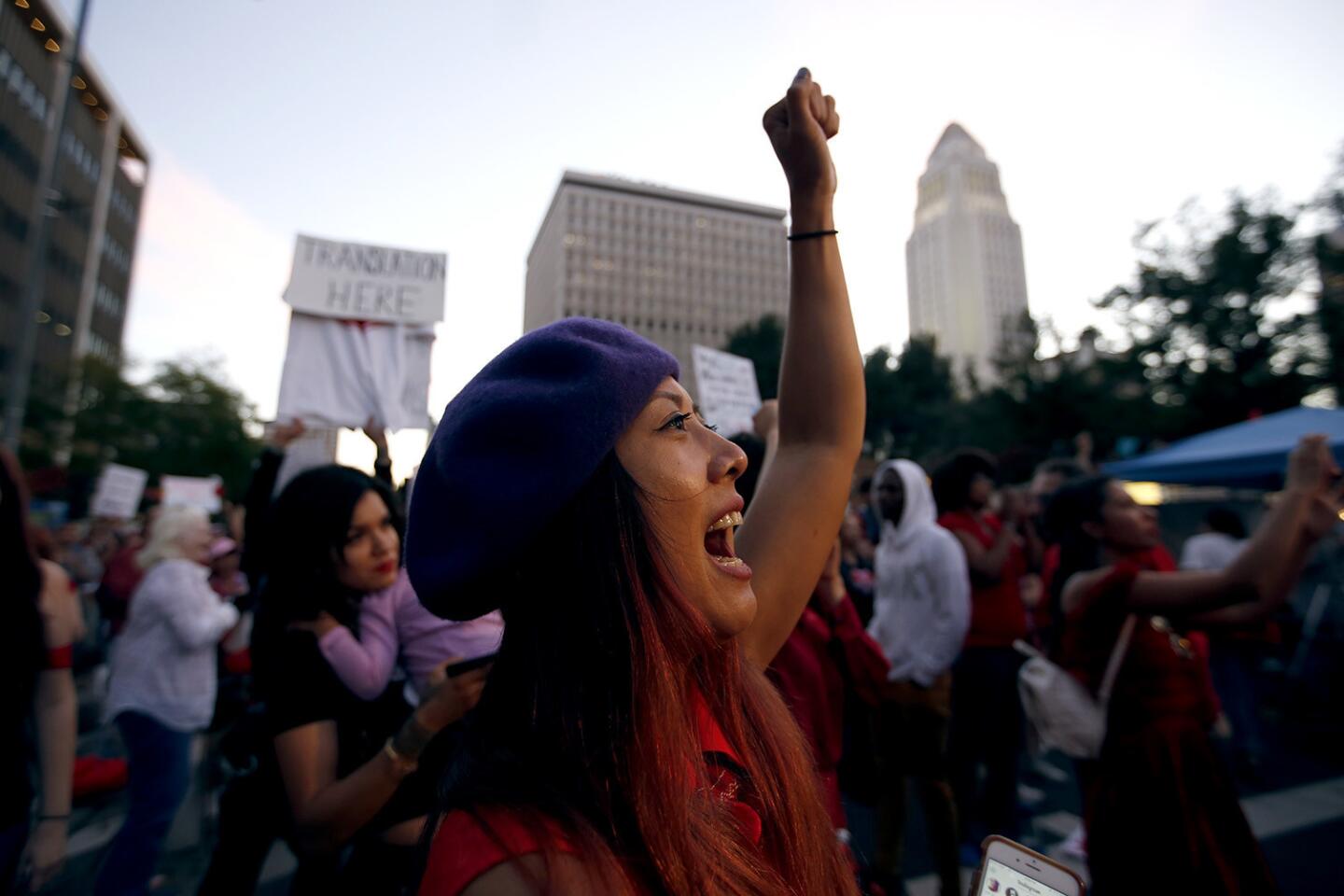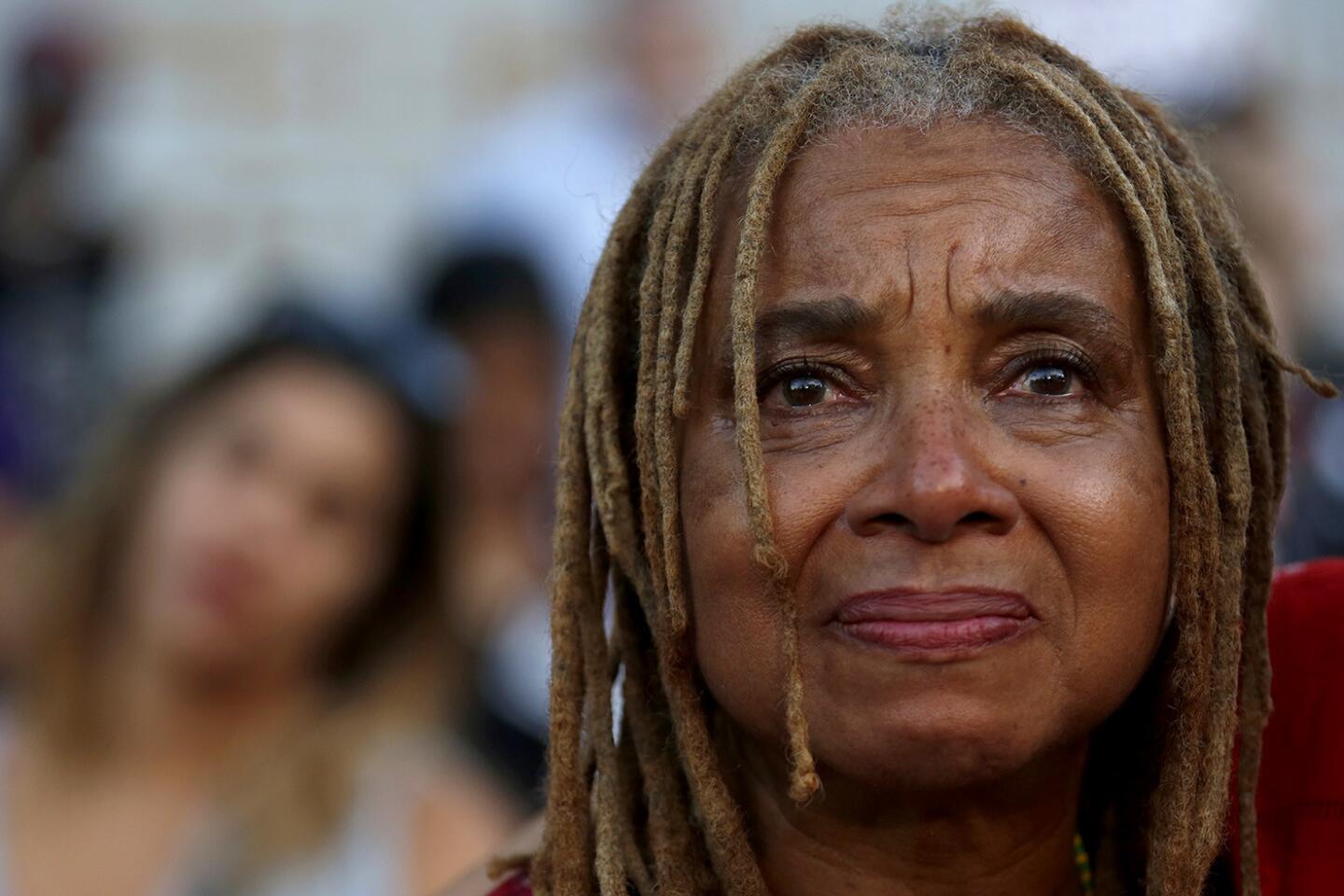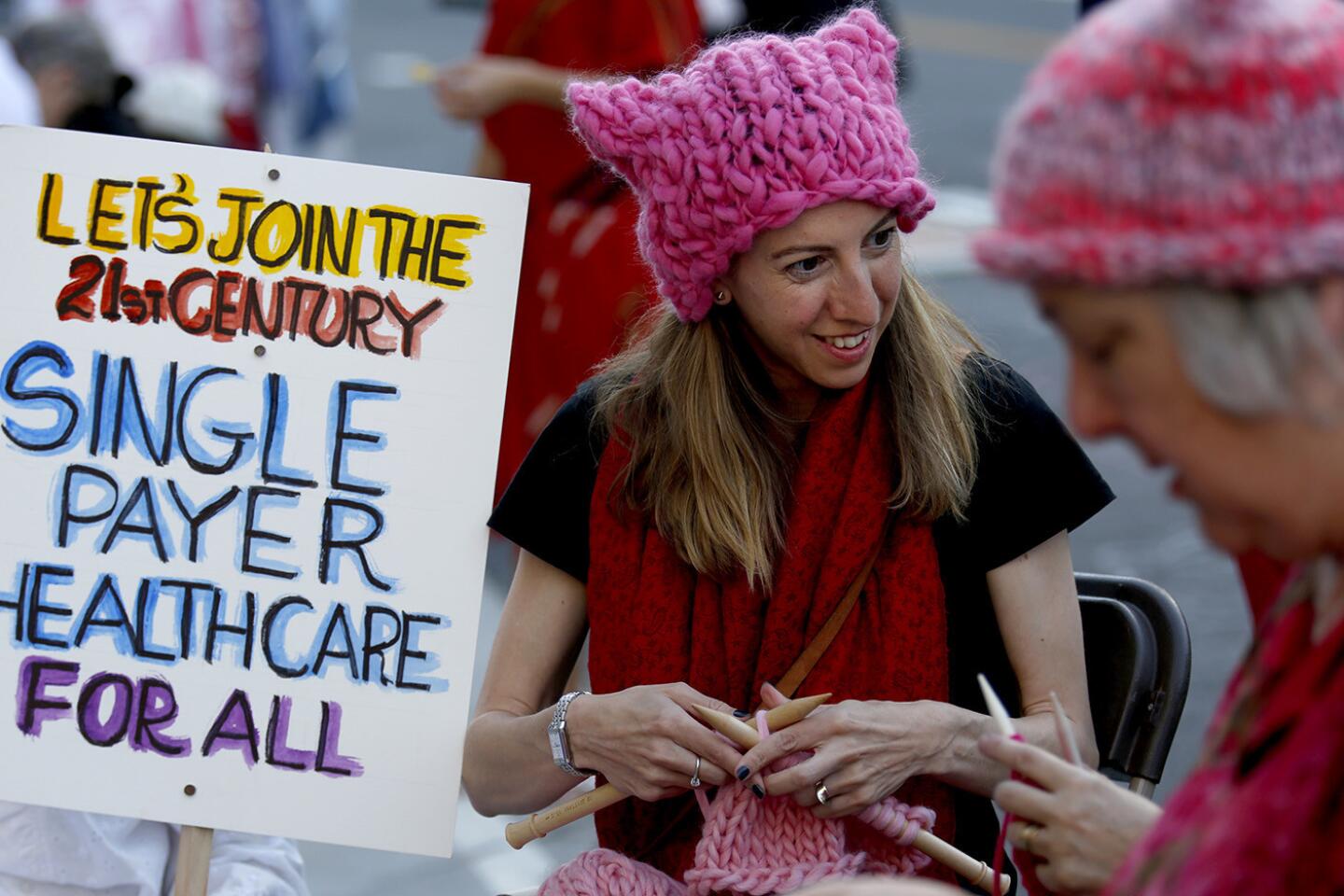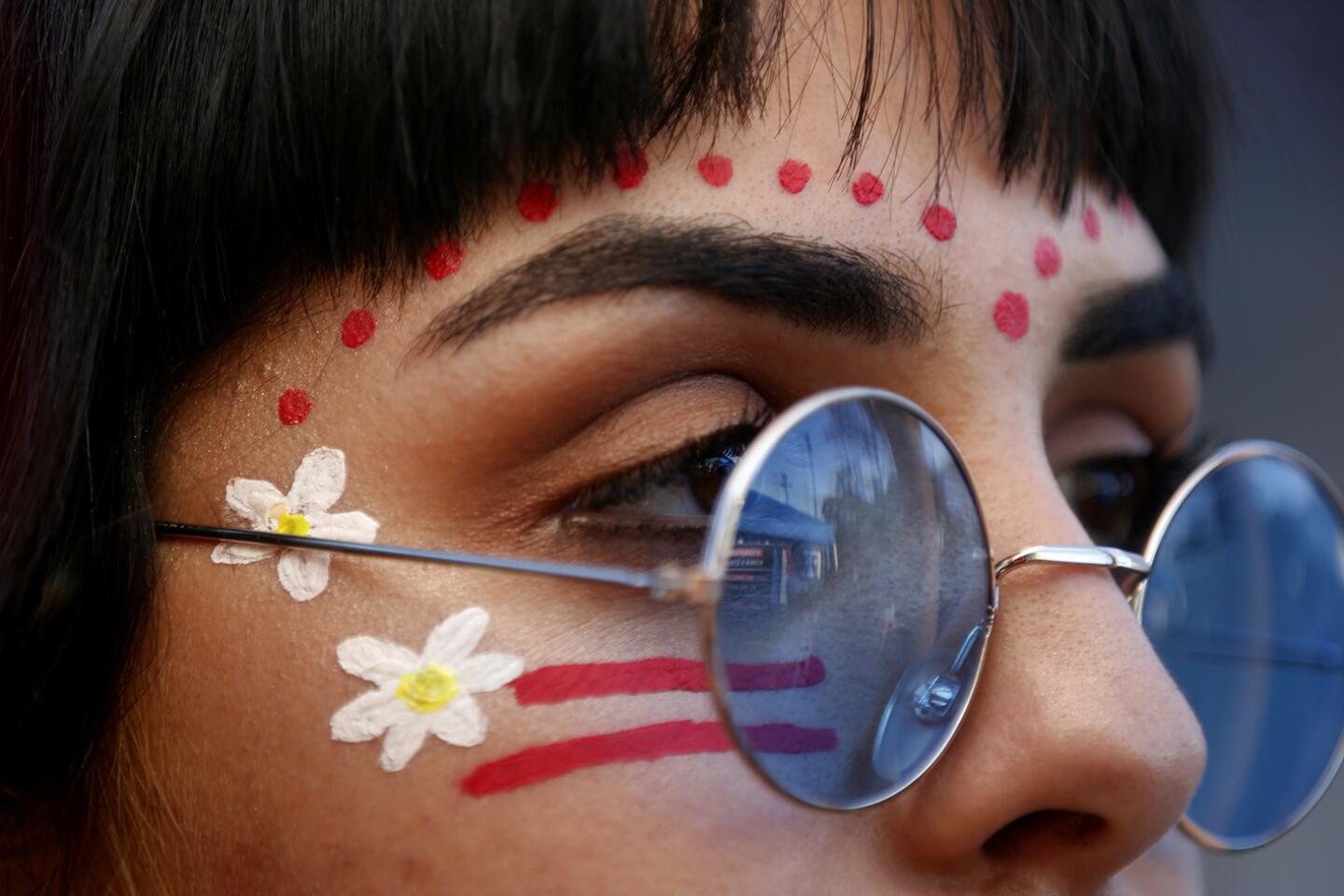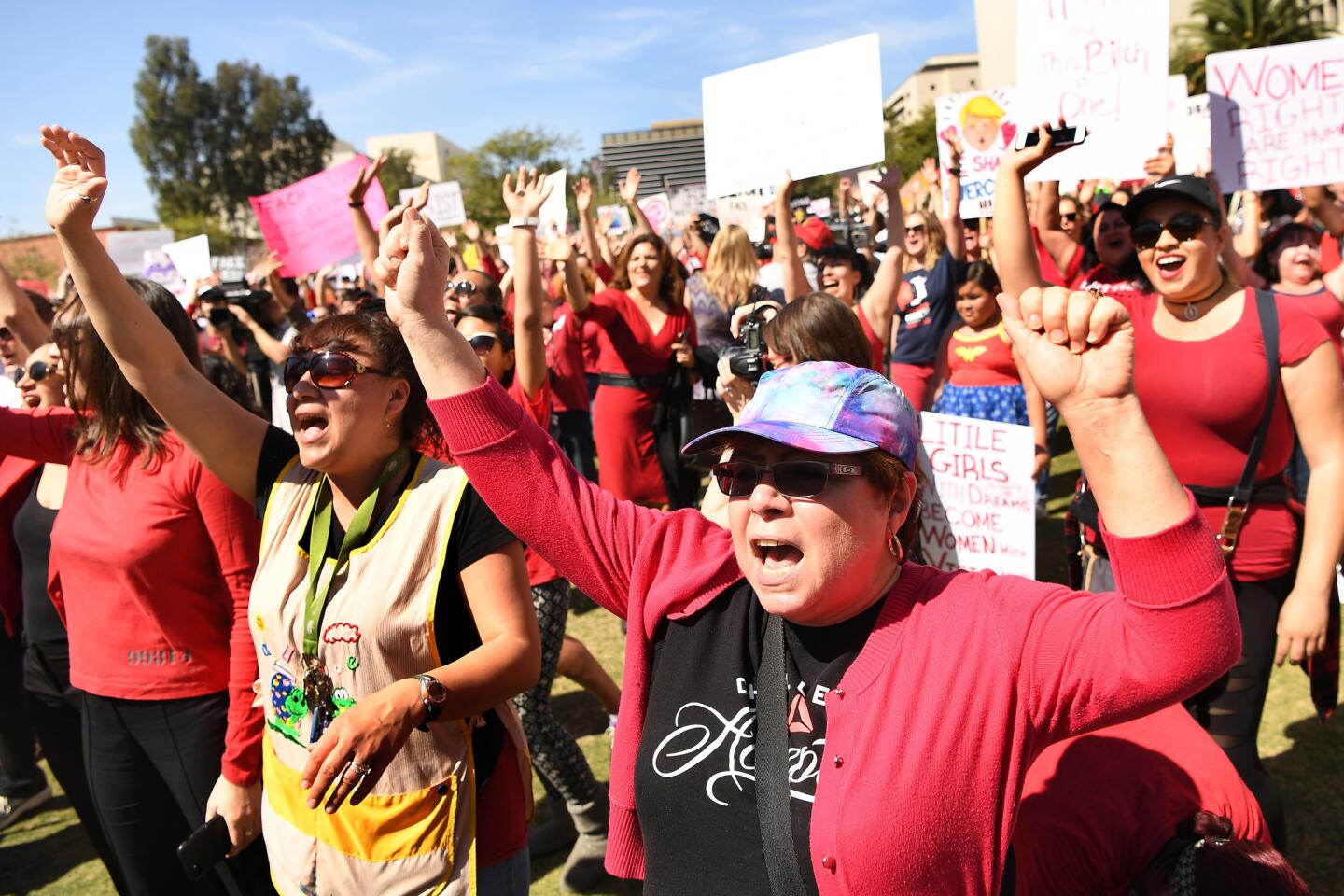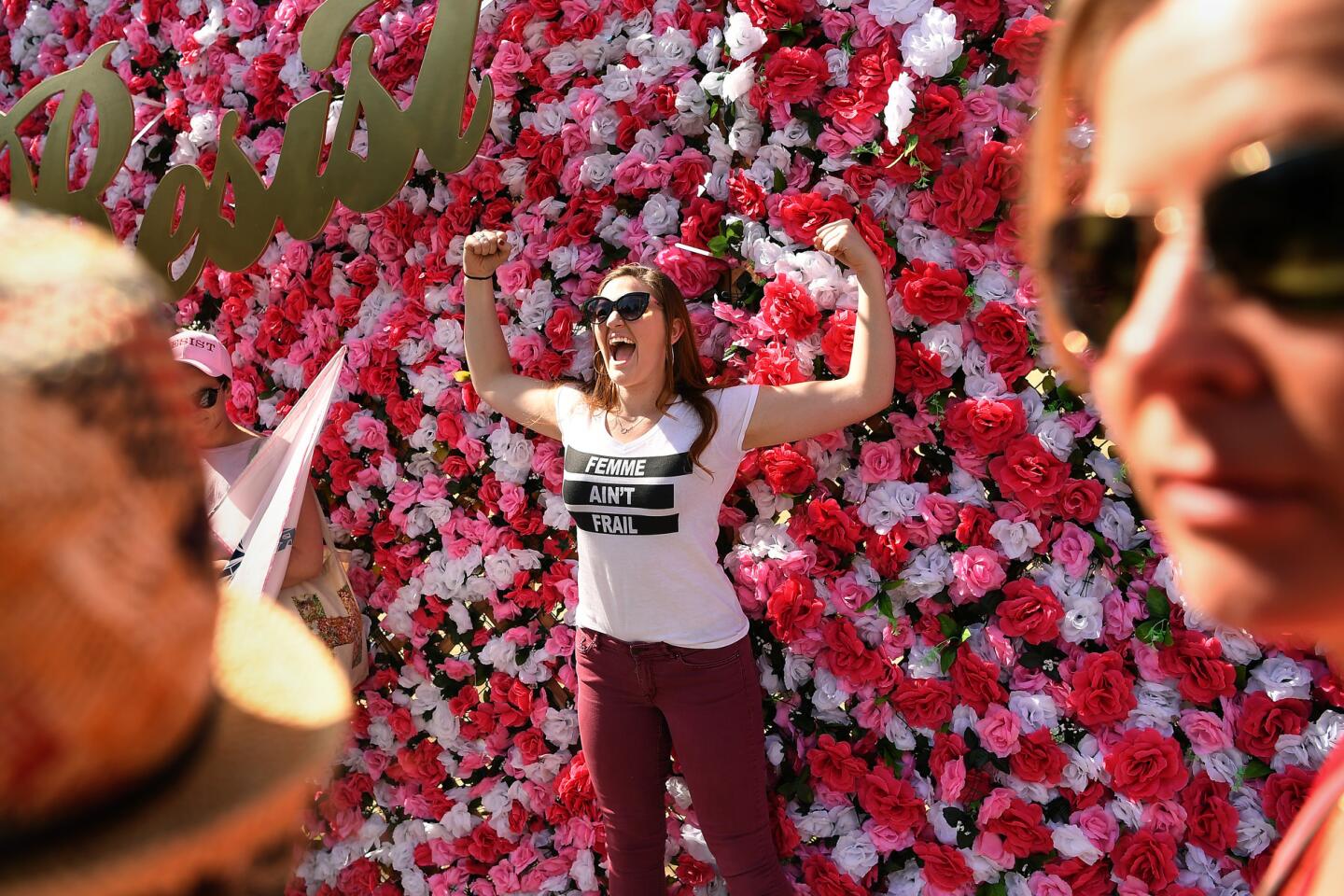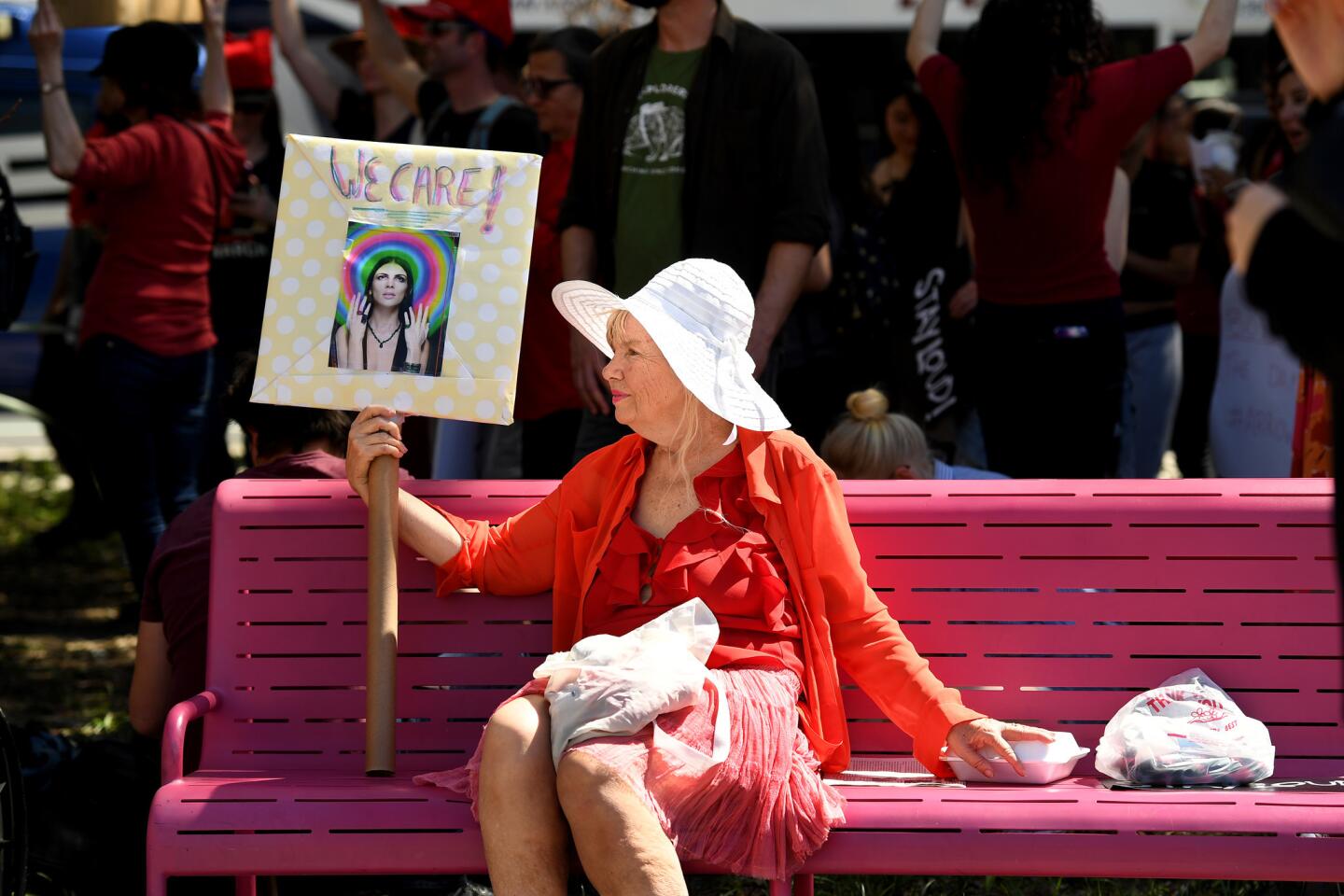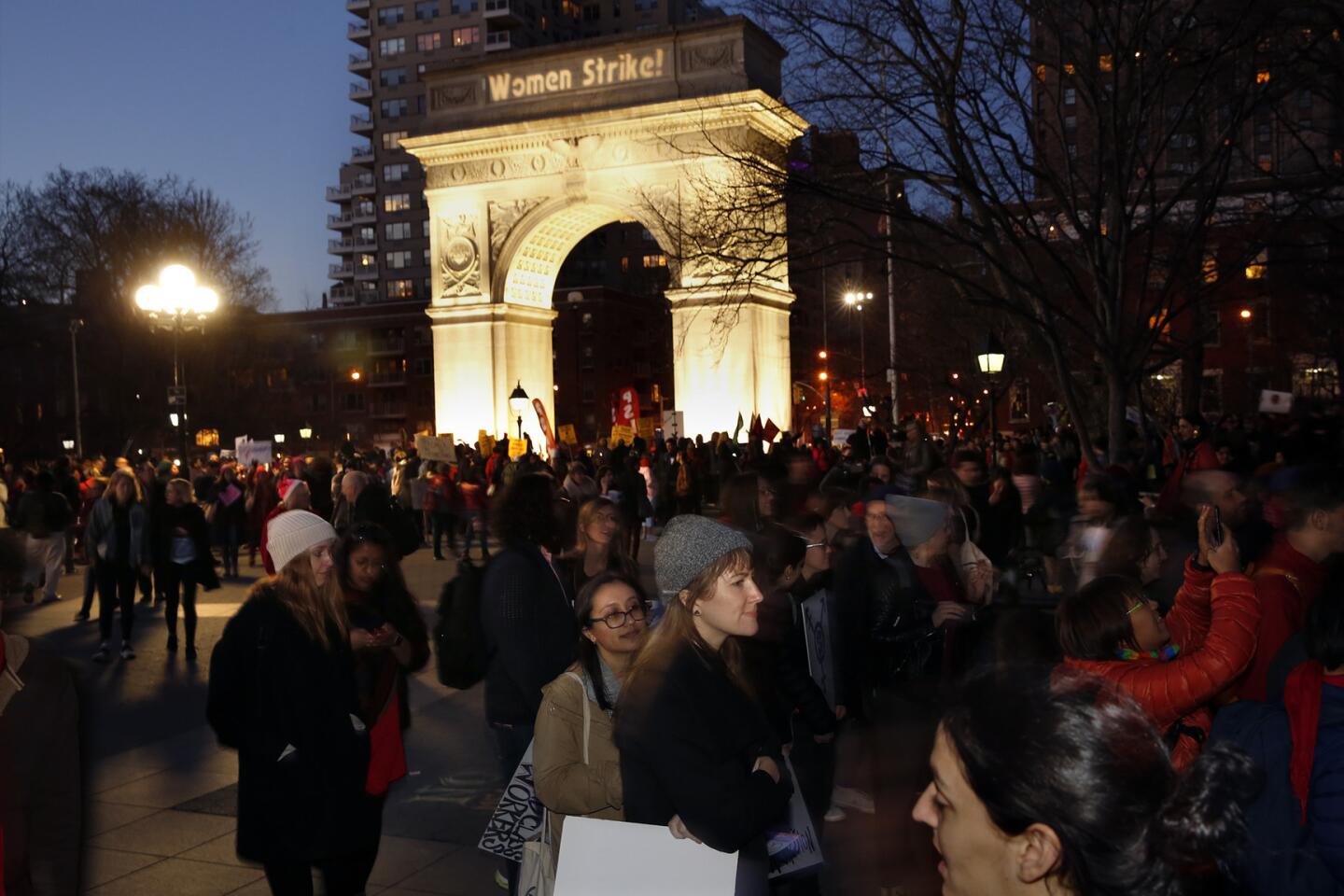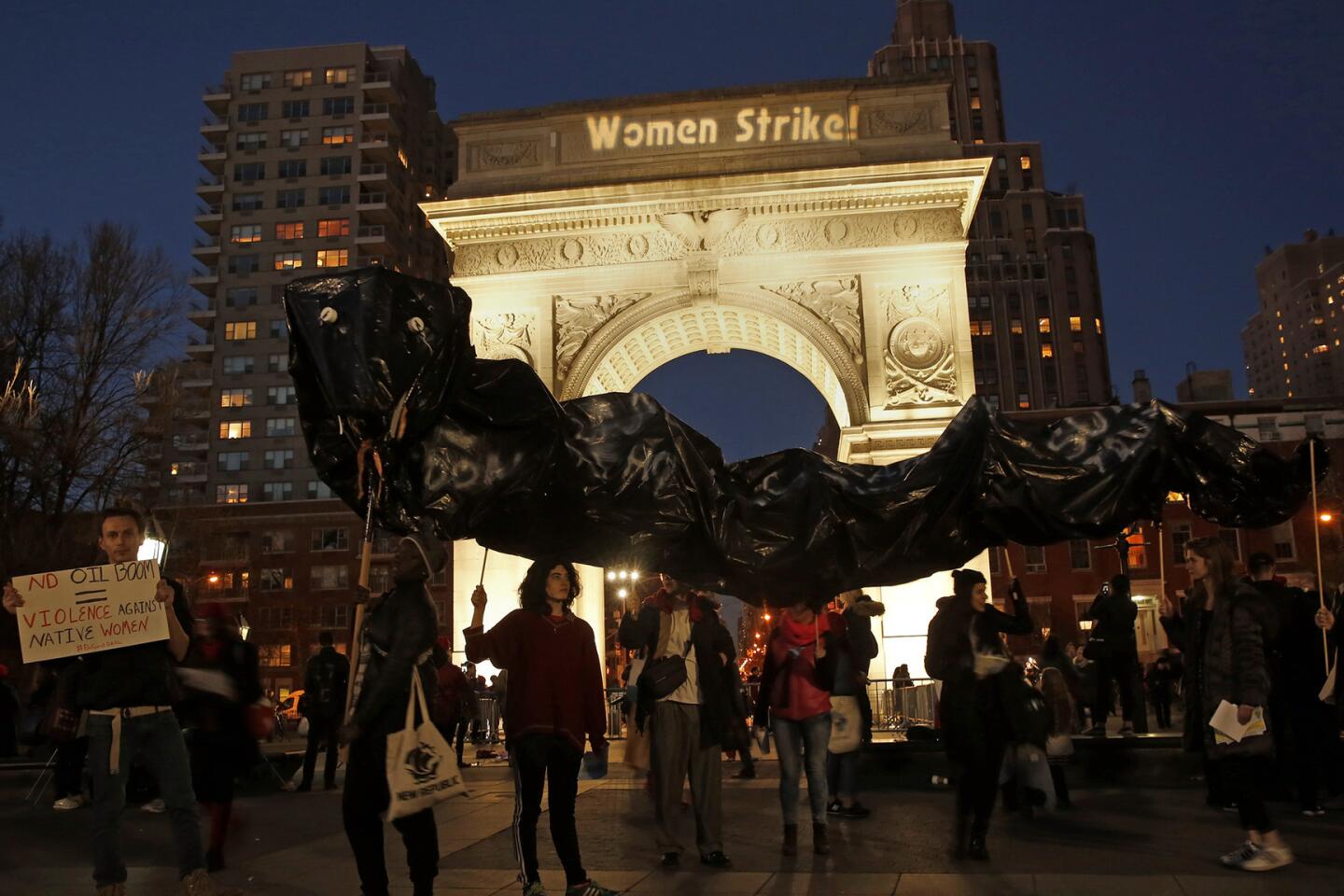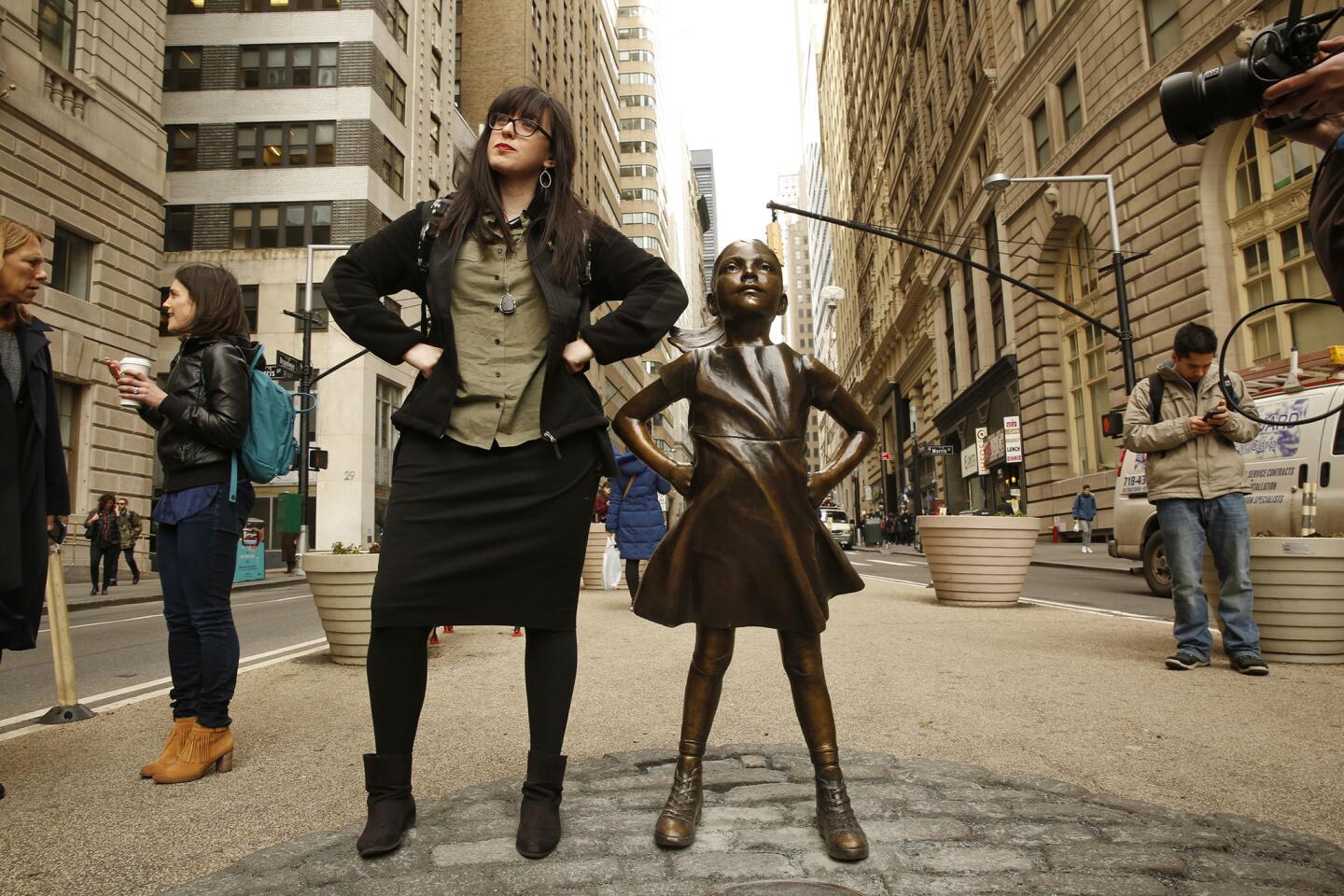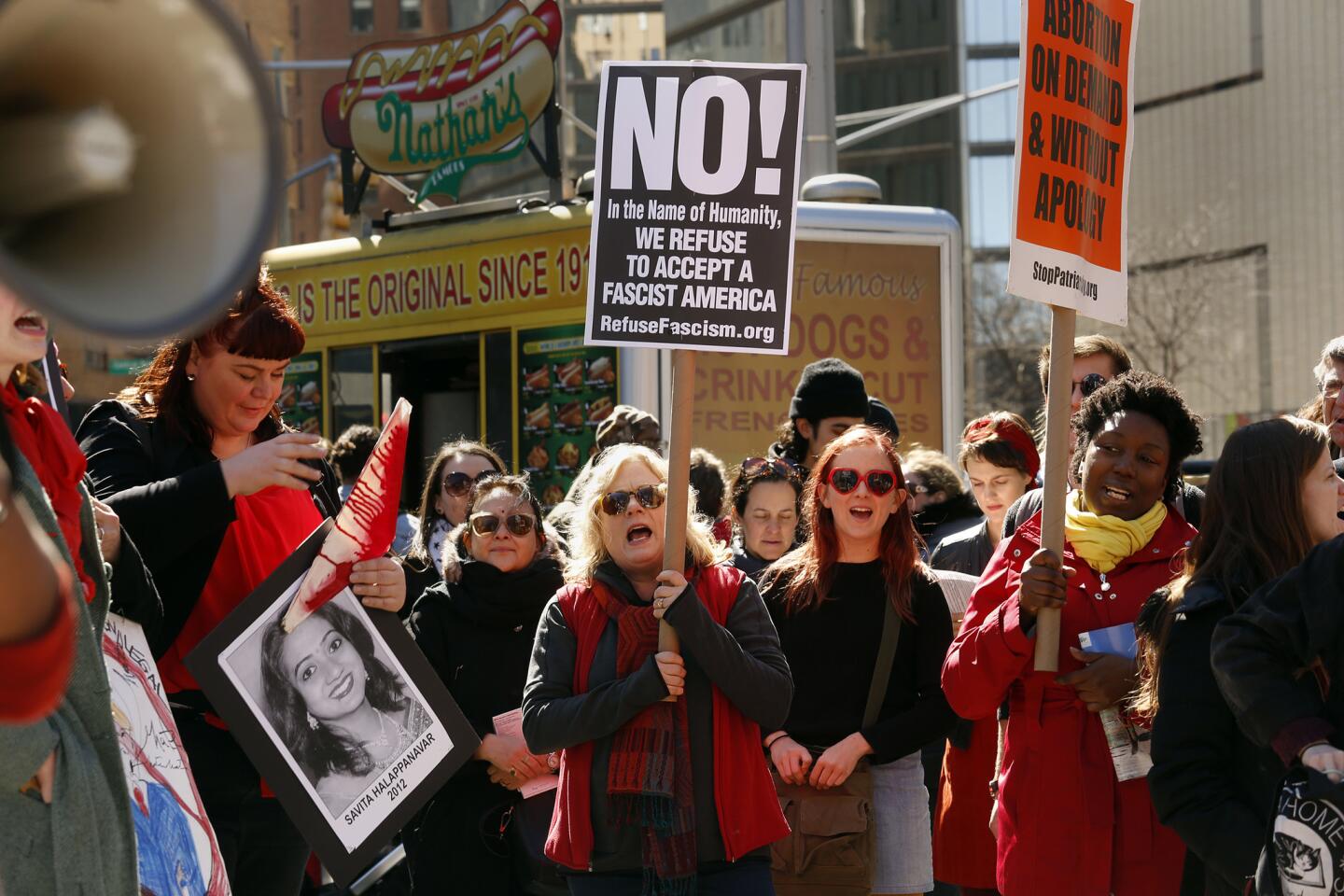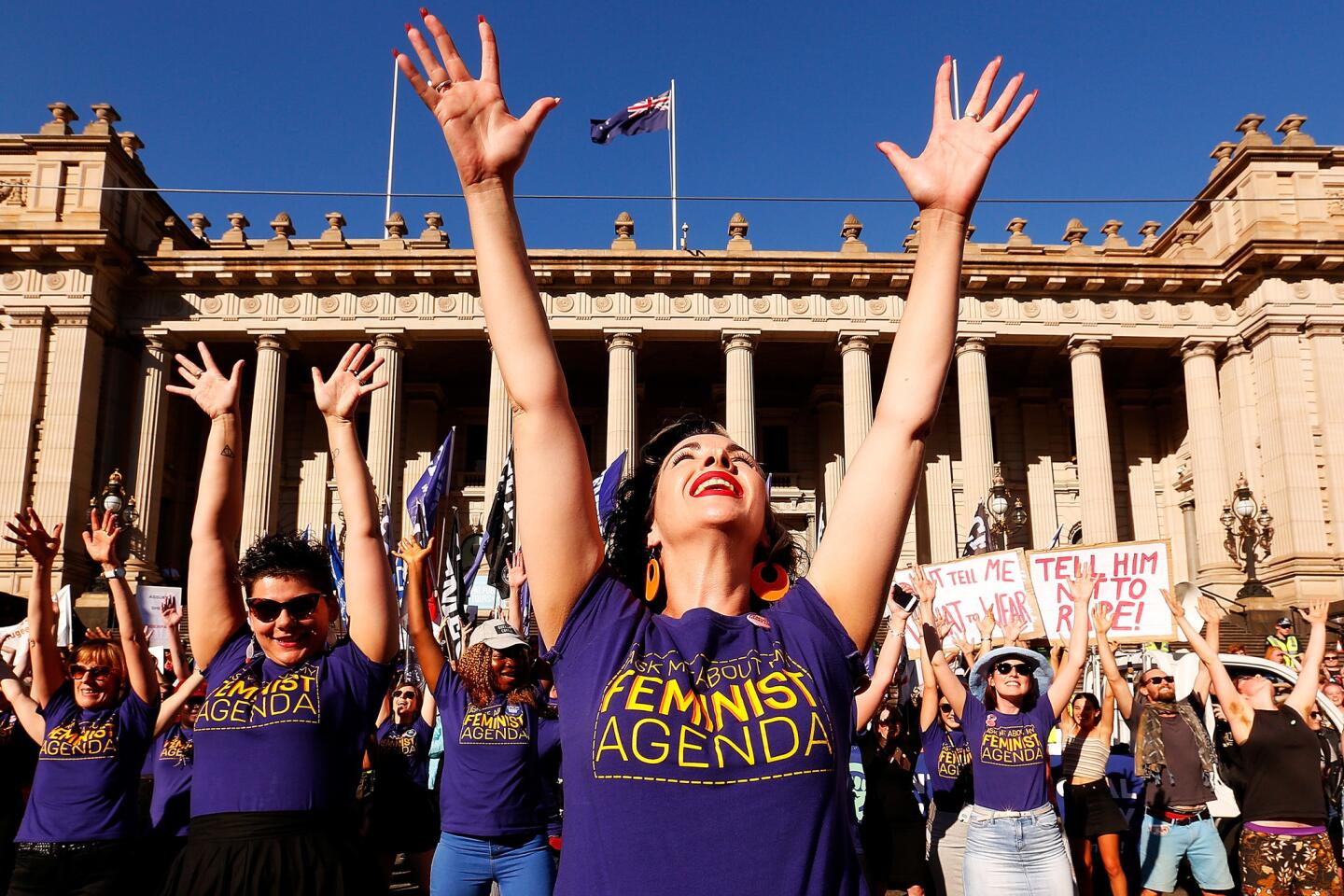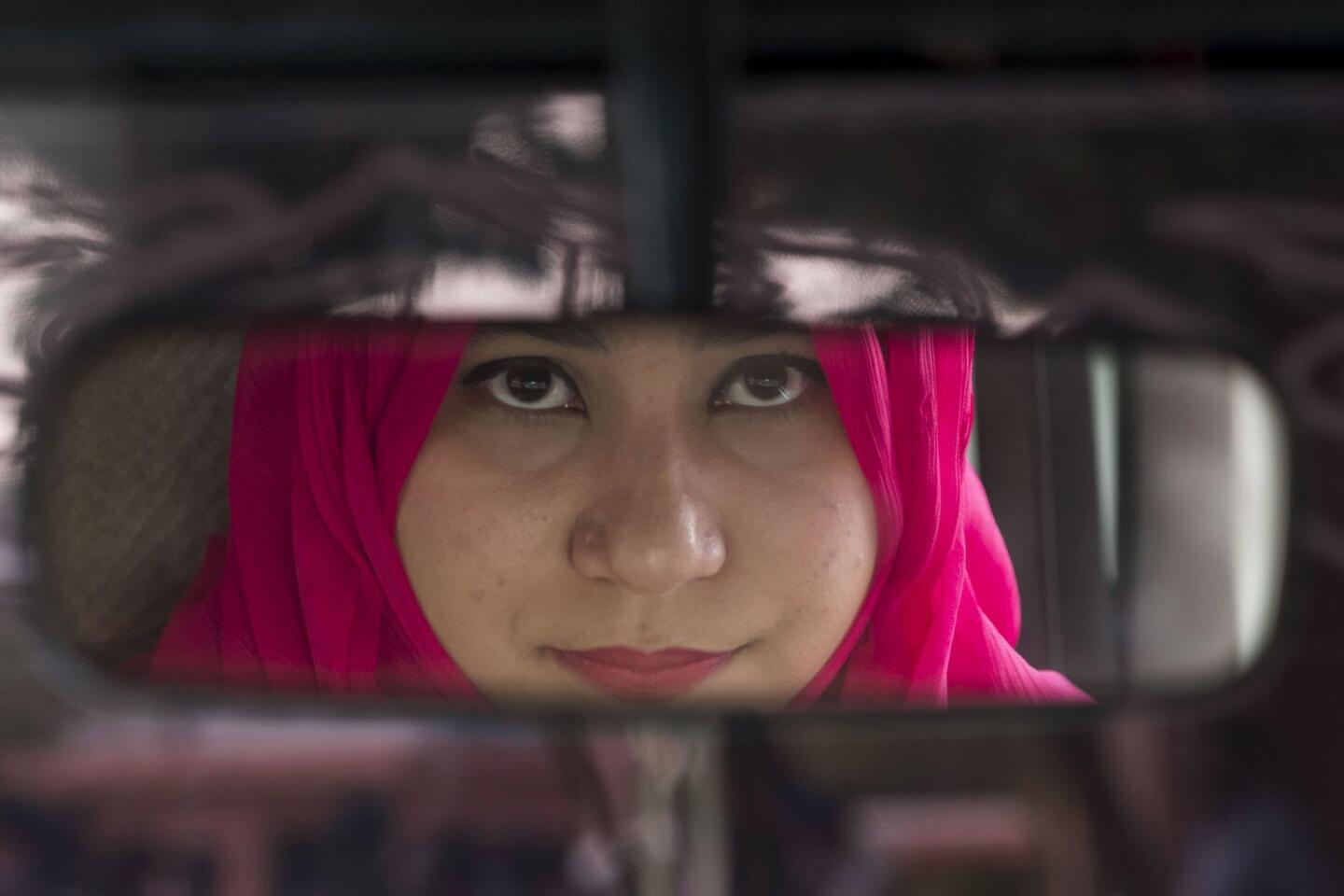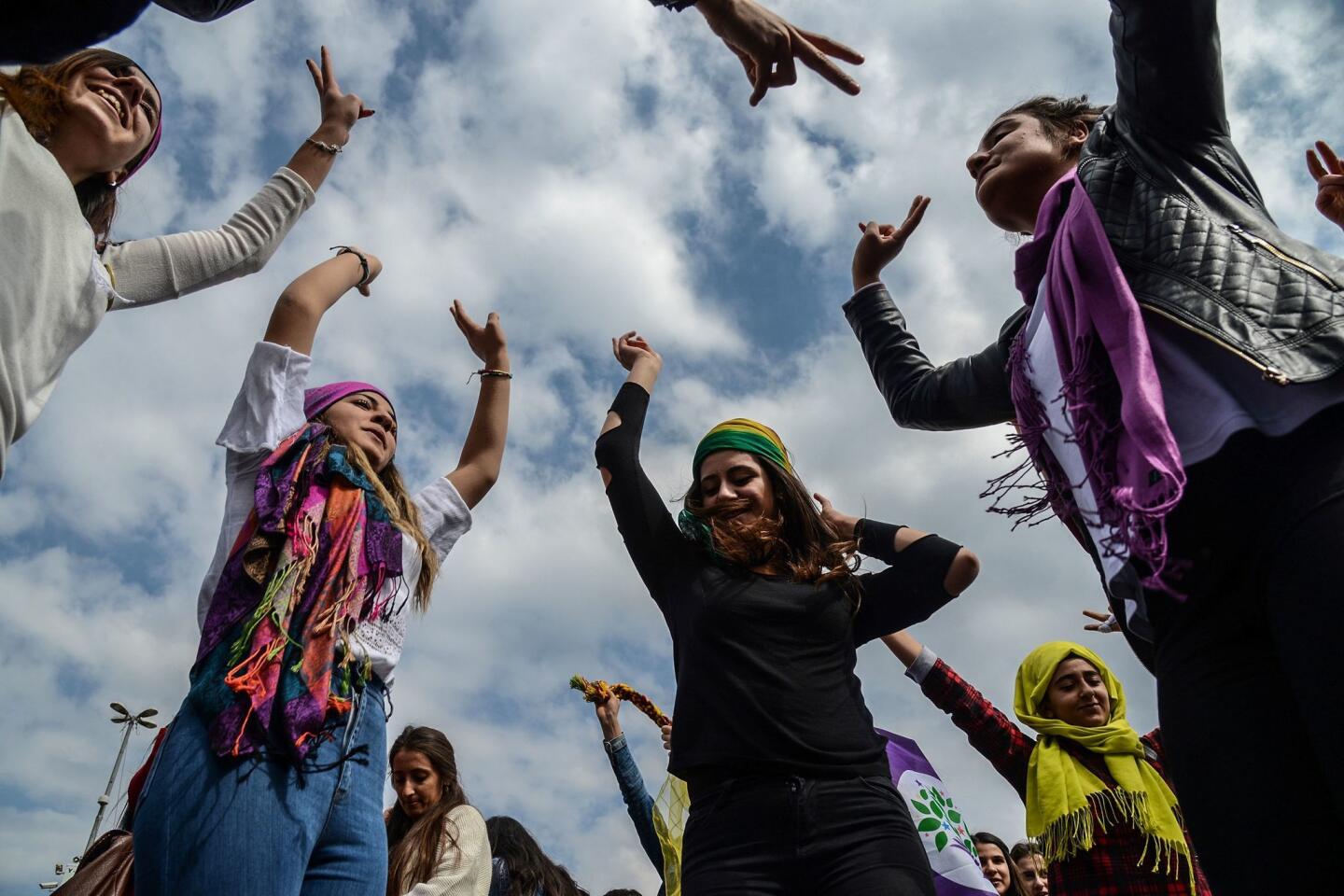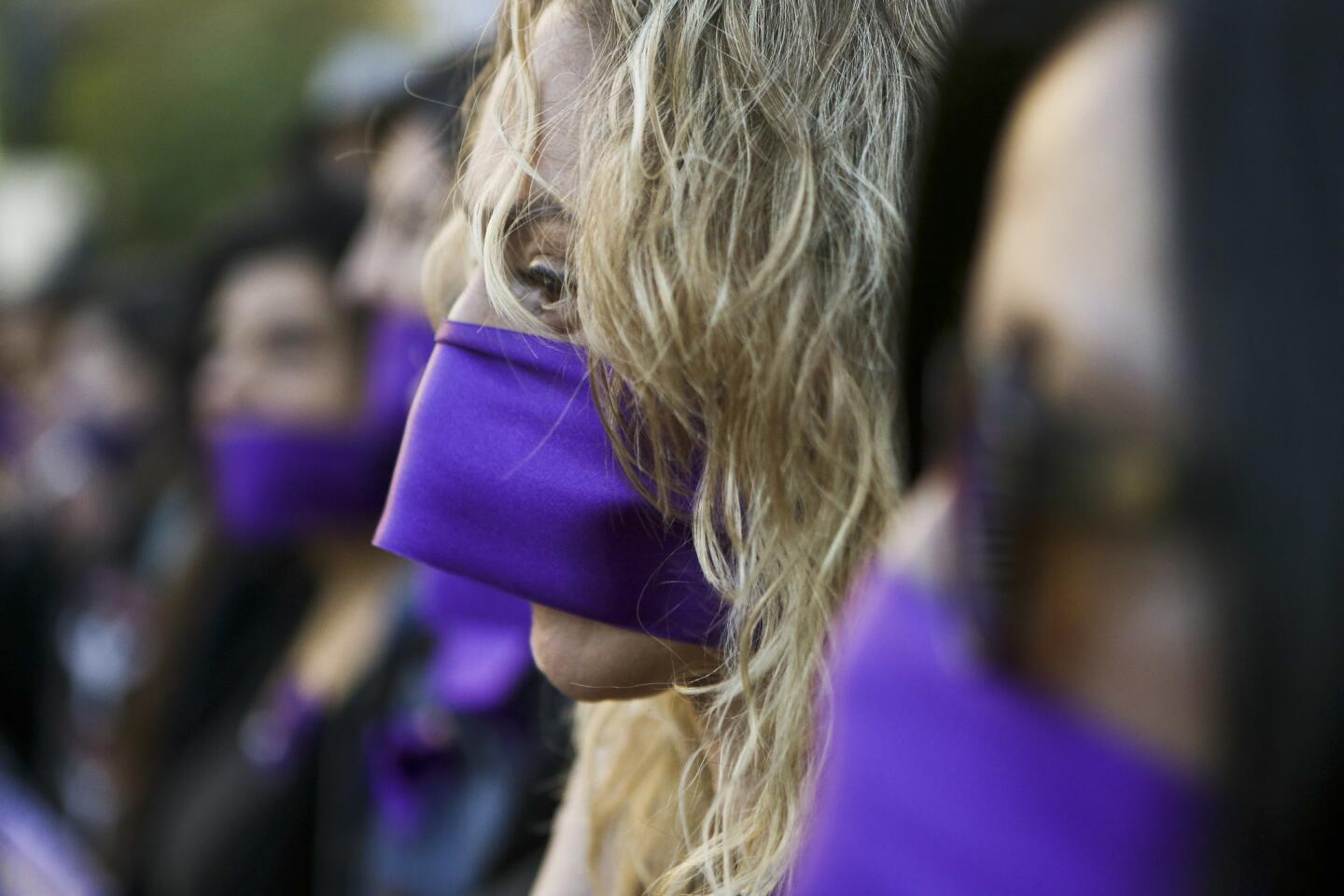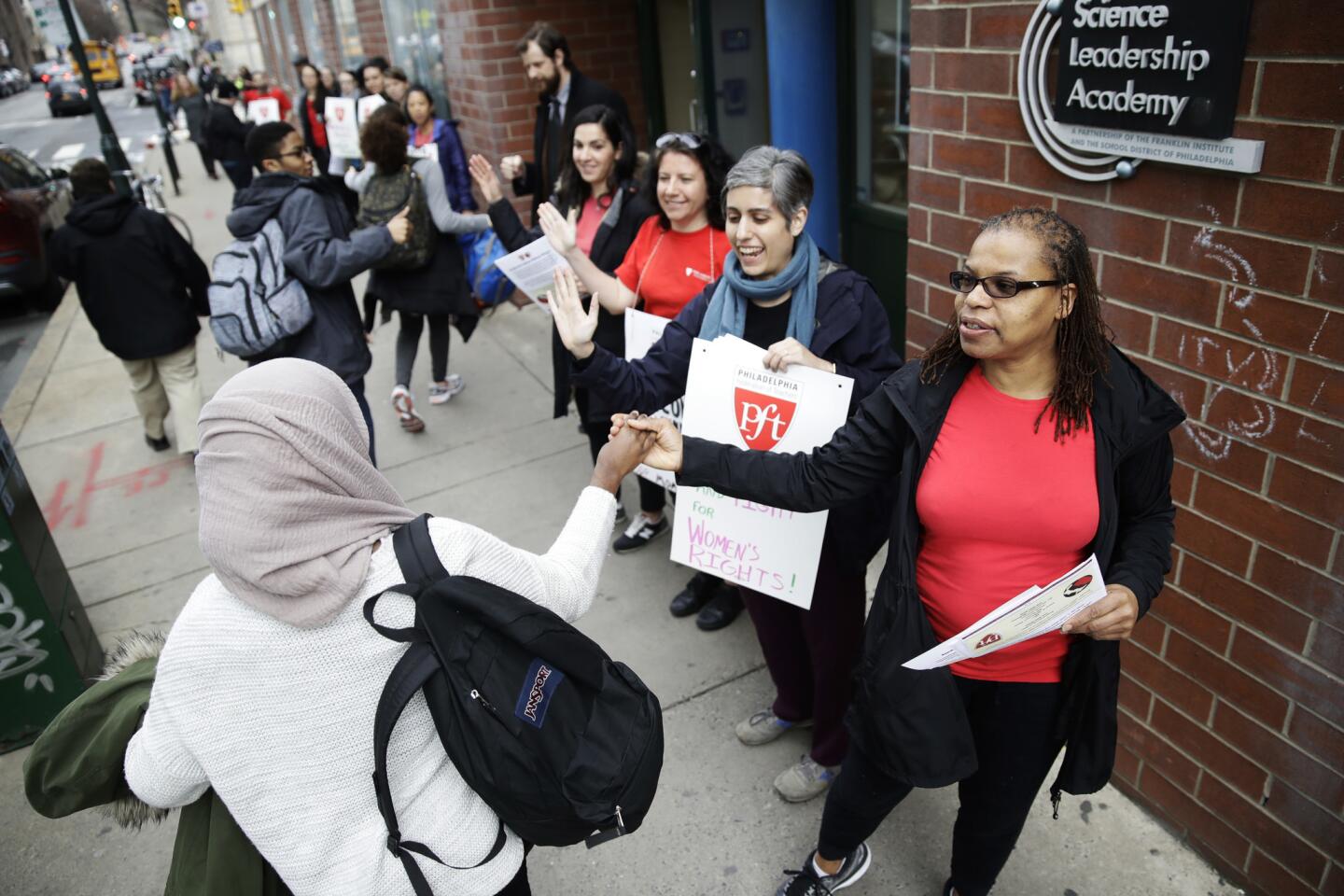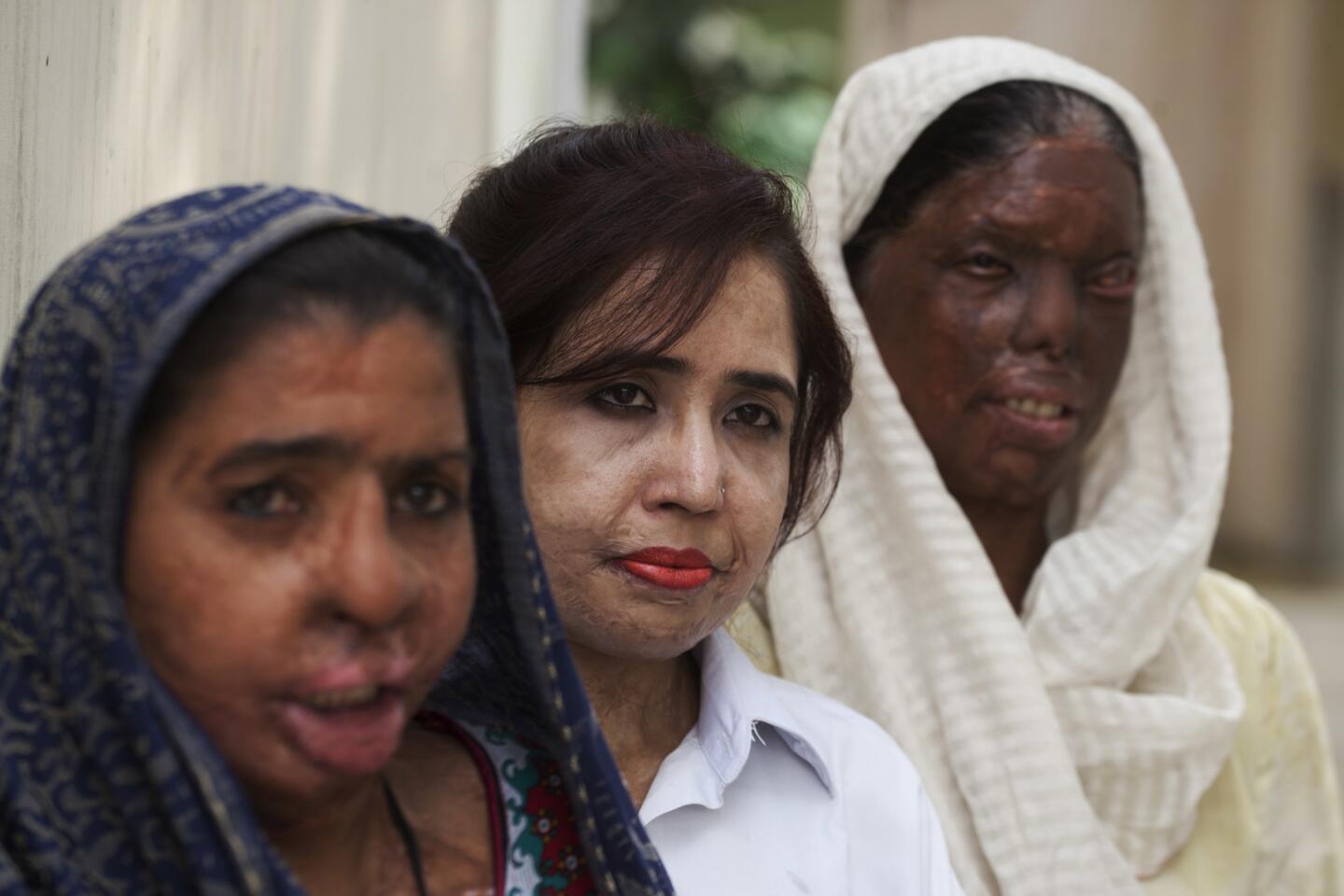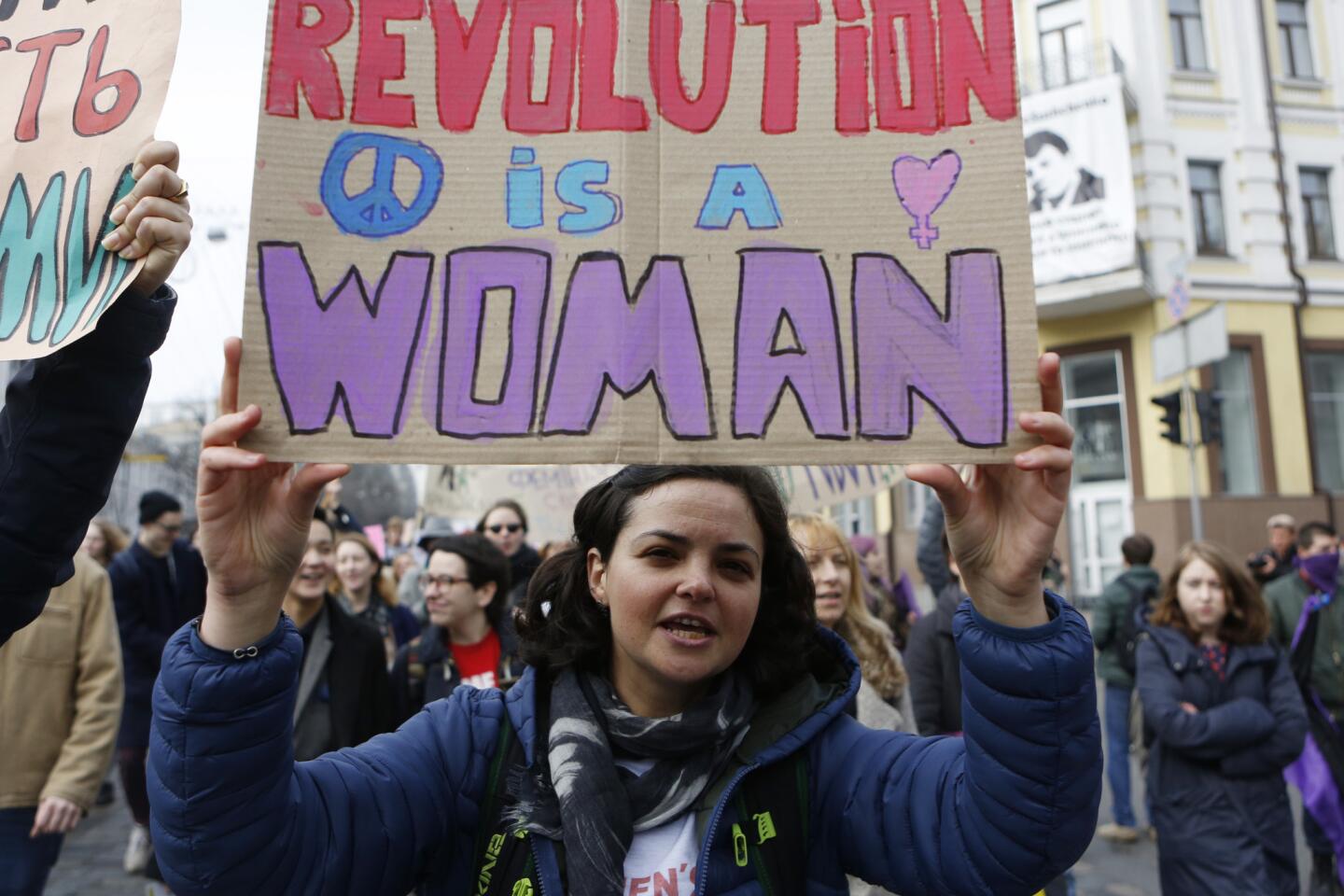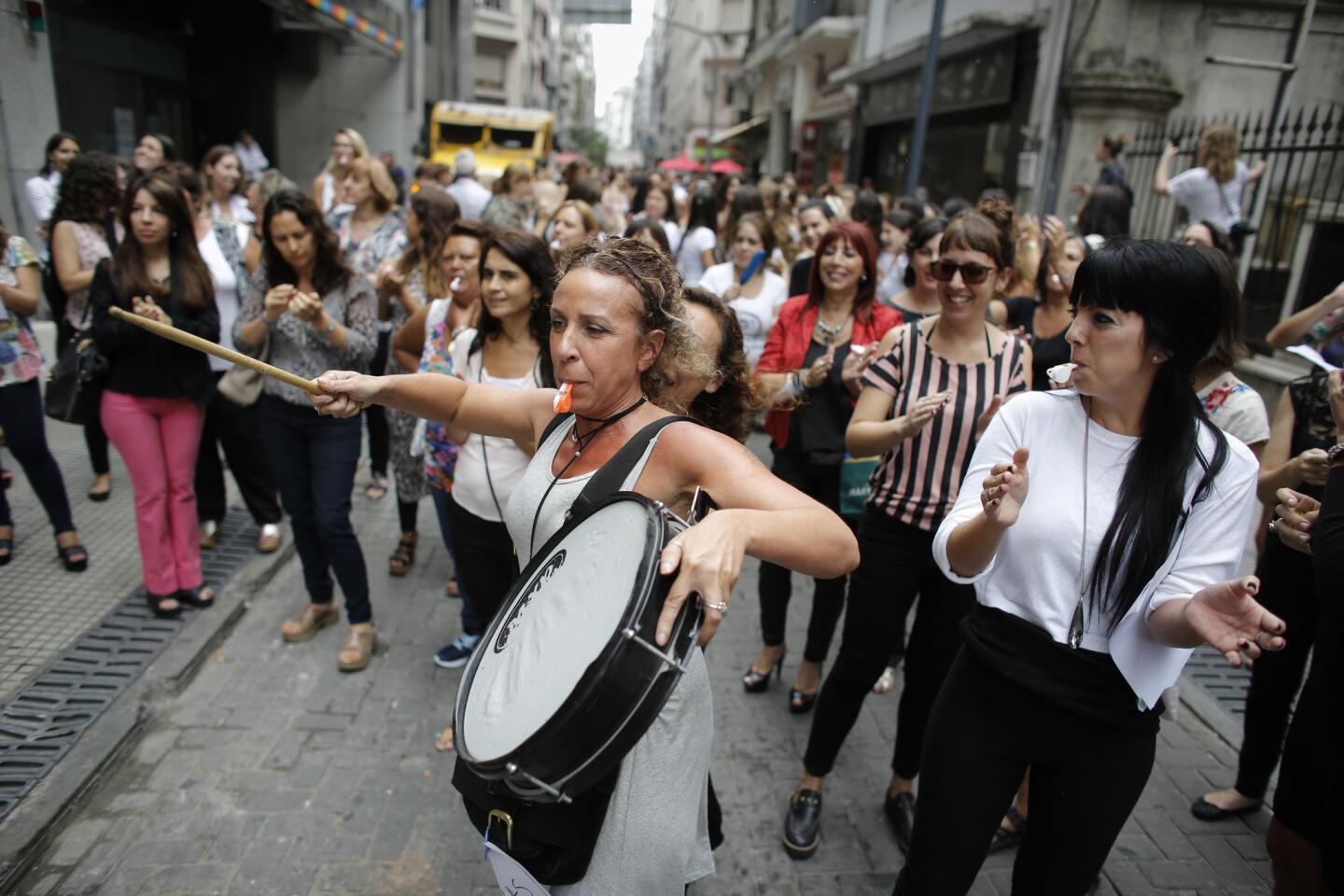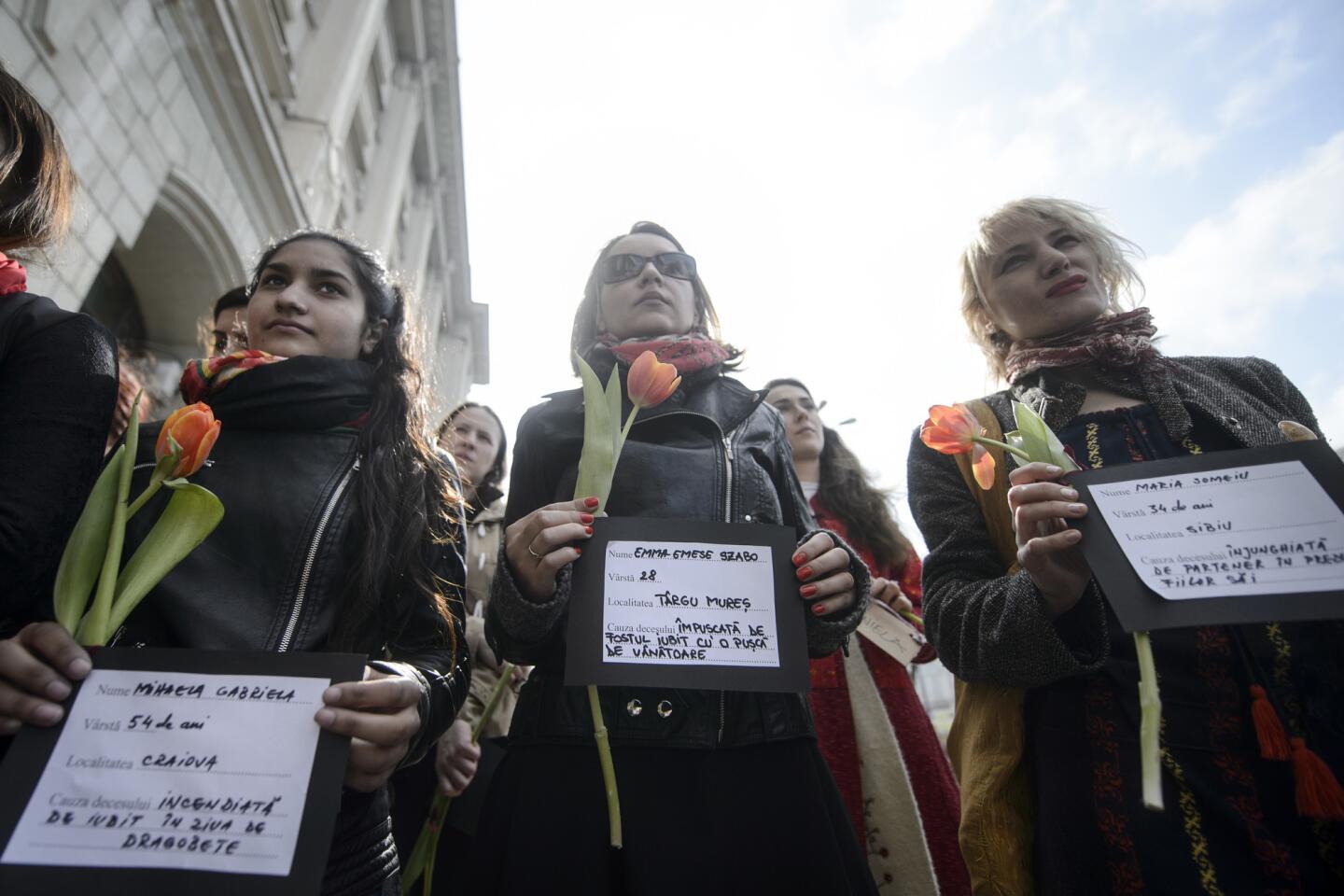‘Women are the backbone of this country’: Thousands across the nation skip work, wear red and rally
Reporting from Washington — Women across the nation took Wednesday off, refrained from shopping, dressed in red and attended rallies to bring attention to their economic clout and the discrimination they face in the workplace and beyond.
Dubbed “A Day Without A Woman,” it was a second act by the organizers of the massive “Women’s March” in Washington and around the globe the day after President Trump was inaugurated.
The impact was hard to gauge. A number of schools and businesses closed for the day or gave female employees the day off. But the crowds who turned out in Washington, New York, Los Angeles and many other places were tiny compared with the millions who flooded the streets on Jan. 21.
House Minority Leader Nancy Pelosi, flanked by other Democratic congresswomen and Hill staff members, addressed a group of cheering supporters from the steps of the Capitol. Many carried signs reading “Women’s rights are human rights” and “Equal pay for equal work.”
“We are in solidarity with women across the country and across the world,” said Pelosi, who delivered a call for girls’ education and the full participation of women in electoral politics. “When women succeed, the world succeeds.”
Watching from the crowd, Nancy McInerney and her friend Janine Dunne were thrilled. “So great to see them all out there together on the steps, dressed in red,” said McInerney, who works for the Smithsonian Institution.
“And to hear about the importance of all these issues — healthcare, women’s economic importance, keeping families together,” said Dunne, a teacher. “It’s not just a flash in the pan.”
But for all their excitement, working women were a visible presence here and in other cities, serving coffee, waiting tables, operating cash registers, mopping floors and issuing parking citations.
Some said they had not heard of “A Day Without A Woman.” Others were just too busy or cash-strapped to take part.
“I can’t afford it,” Sabrina Lott said as she hauled a trash can, bucket and mop through a busy food court at the Peachtree Center business complex in downtown Atlanta. Without the $60 she earns from her daily cleaning shift, she said, she would struggle to pay her bills, buy groceries and care for her sick brother.
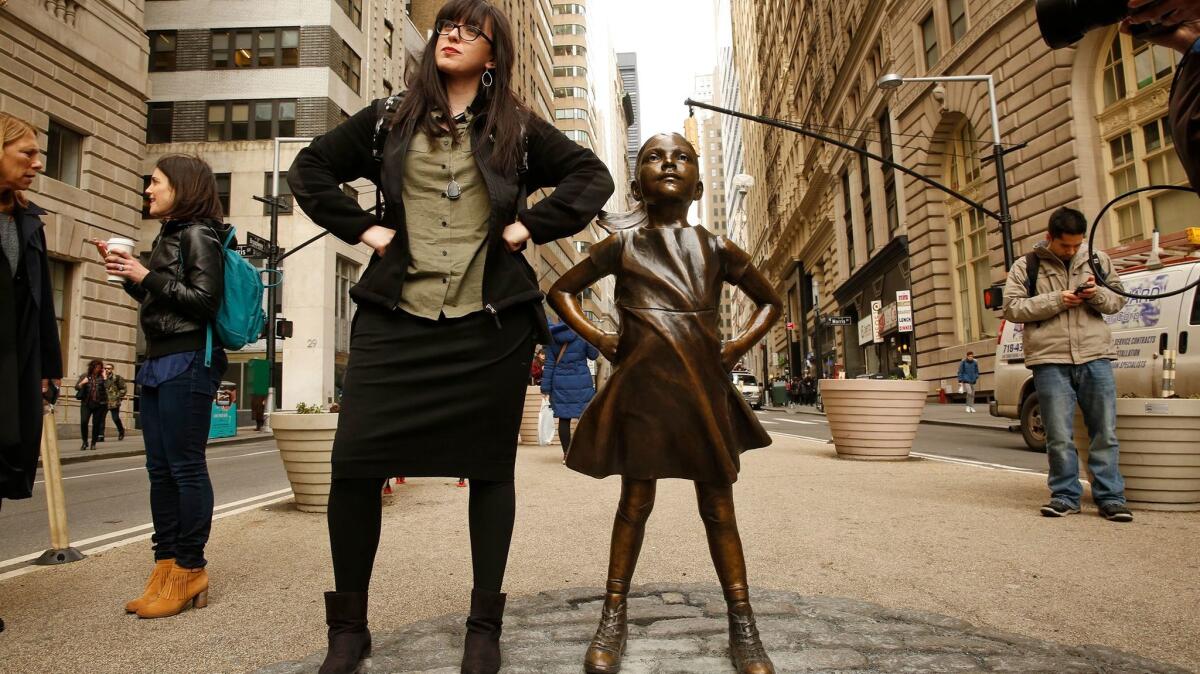
Others said the protests could have been better promoted.
“I guess we didn’t get the memo,” said Tonya Murray, a call center worker who was smoking a cigarette on Peachtree Street during her morning break. “We have 60 people working, and only two guys.”
Even if she had known, though, she wouldn’t have participated. She started her job just two weeks ago and didn’t want to give her boss the wrong impression.
Still, she thought a strike was a good idea.
“Women are the backbone of this country,” she said. “We do it all — we are the most organized and compassionate workers — and we do it knowing our counterparts are paid more.”
Organizers acknowledged that many women couldn’t afford to take time off and said on their website, “We strike for them.” They also encouraged women to wear the color red as a sign of solidarity.
The protests were timed to coincide with International Women’s Day, which dates back to the early 1900s and is marked around the world with strikes and rallies to celebrate the achievements of women and call for gender equality.
Organizers also drew inspiration from last month’s “Day Without An Immigrant,” which shut down restaurants and grocery stores as Trump took aim at illegal immigration.

On International Women’s Day, Los Angeles City Councilwoman Nury Martinez led a presentation acknowledging the women who make up the city workforce.
Trump urged his legions of Twitter followers to join him Wednesday in “honoring the critical role of women here in America & around the world.”
“I have tremendous respect for women and the many roles they serve that are vital to the fabric of our society and our economy,” he tweeted.
Women make up more than 47% percent of the U.S. workforce and dominate certain professions, including nursing and teaching, census data show.
School districts including Alexandria City Public Schools in Virginia, Prince George’s County Public Schools in Maryland and Chapel Hill-Carrboro Schools in North Carolina canceled classes because of the number of staffers who requested time off.
In Prince George’s County, a district of 130,000 students, the closures sent many parents scrambling for last-minute child care. Unaware of the protest, some showed up at schools with kids to drop off.
“I am lucky my boy is big and could be alone, because I needed to get to work,” said Alex Martins, a taxi driver and the sole guardian of his 17-year-old nephew, a senior at Dr. Henry A. Wise Jr. High School in Upper Marlboro, Md. “For people with little ones, it was a bad surprise.”
District officials in Alexandria tried to alleviate such problems by opening city recreation centers to the 15,000 kids getting an unexpected day off.
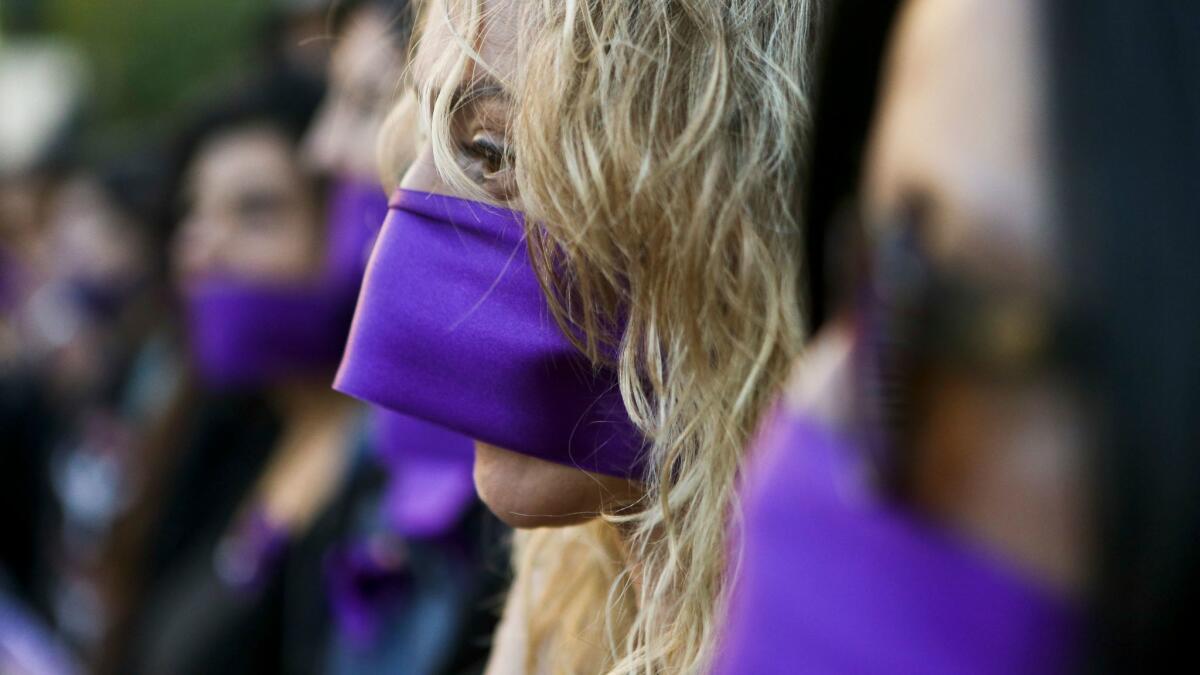
In Madison, Wis., hundreds of high school students walked out of class to march to the state capitol. In Providence, R.I., the municipal court was closed due to insufficient staff.
Women in New York joked that the first participant in the strike was none other than the city’s most illustrious female resident, Lady Liberty.
For several hours Tuesday night, the Statue of Liberty went dark, her body and robes cloaked in black with only her torch shining on New York Harbor. The National Park Service, which operates the monument, blamed a “technical glitch.” But to some, the timing seemed too perfect to be coincidental.
“Lady Liberty got the memo,’’ the protest organizers crowed on Twitter. “Thank you Lady Liberty for standing with the resistance and going dark for #DayWithoutAWoman.”
Women in New York were also delighted by the sudden appearance on Wall Street of a bronze statue of a young girl, who appears to be staring down the iconic statue of a bull in one of New York’s most testosterone-fueled neighborhoods. Called “Fearless Girl,” it was commissioned by the financial firm State Street Global Advisors to protest the shortage of women on corporate boards.
“I think it is exactly what needs to be here,’’ said Layah Shagalow, who works in the financial district.
Small demonstrations popped up around the city, including a midday gathering of several thousand women — and some men — in Central Park.
Friederike Fleschenberg, a historian from Berlin now living in New York, said she wasn’t really able to take the day off because she is caring full time for her young children. So she bundled up her year-old daughter in red and brought her to the demonstration.
“As a historian, I’ve spent much of my life trying to understand how could the Holocaust happen, and so I know we have to work hard to protect the freedoms we have,’’ Fleschenberg said.
At least 13 women were arrested as they tried to encircle the Trump International Hotel at the southwest corner of the park. “We are blocking traffic as a form of civil disobedience,’’ the march organizers said on their official Twitter account.
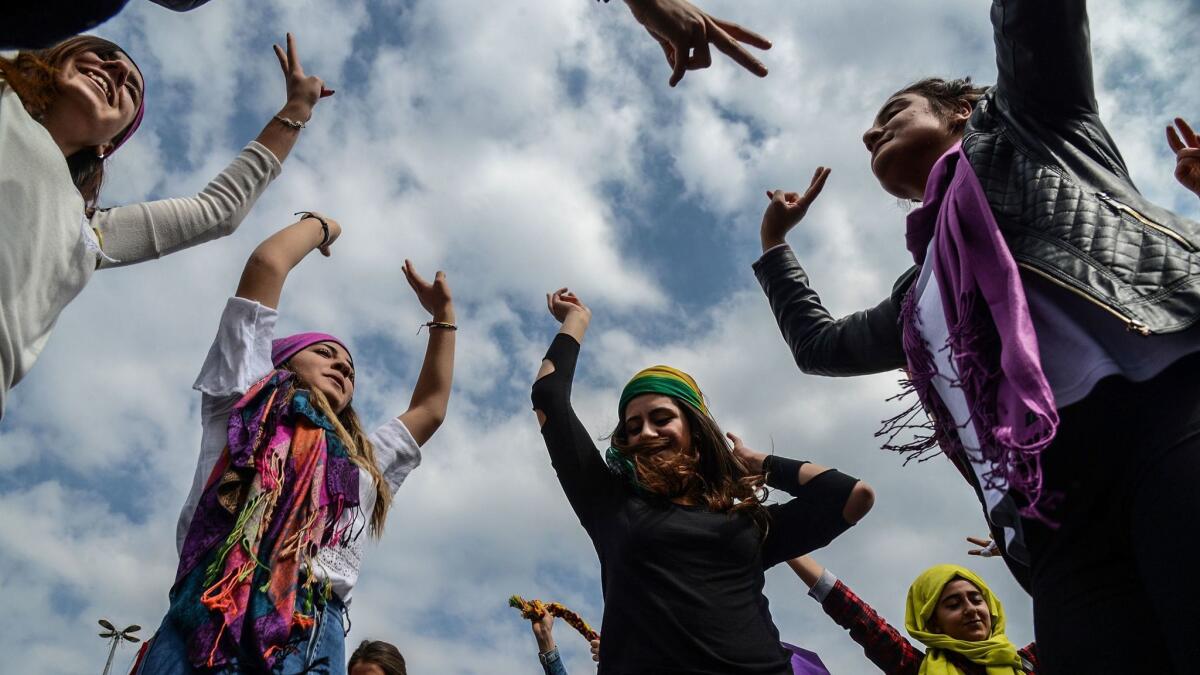
In Washington, marchers gathered in a downtown plaza to protest the restoration of a policy requiring that overseas family-planning groups refrain from performing or promoting abortions as a condition for receiving U.S. aid.
Another rally, staged outside the Department of Labor, was meant to spotlight issues such as wage inequality but drew marchers worried about everything from minority rights to environmental causes.
With flashes of red standing out on the streets — hoodies, sweaters, scarves — a number of Washington businesses lent symbolic support and made cash donations to women’s causes.
Chef Ruth Gresser, who owns four eateries in Washington, offered paid leave to all female employees and served up a special menu with half the usual food and beverage offerings, representing women’s share of the population.
“It was really busy without them,” said bartender Daniel Weber, who was filling in for female colleagues at a Pizzeria Paradiso branch near downtown where the lines were out the door. “But I support them and what they are standing up for, so I didn’t mind at all.”
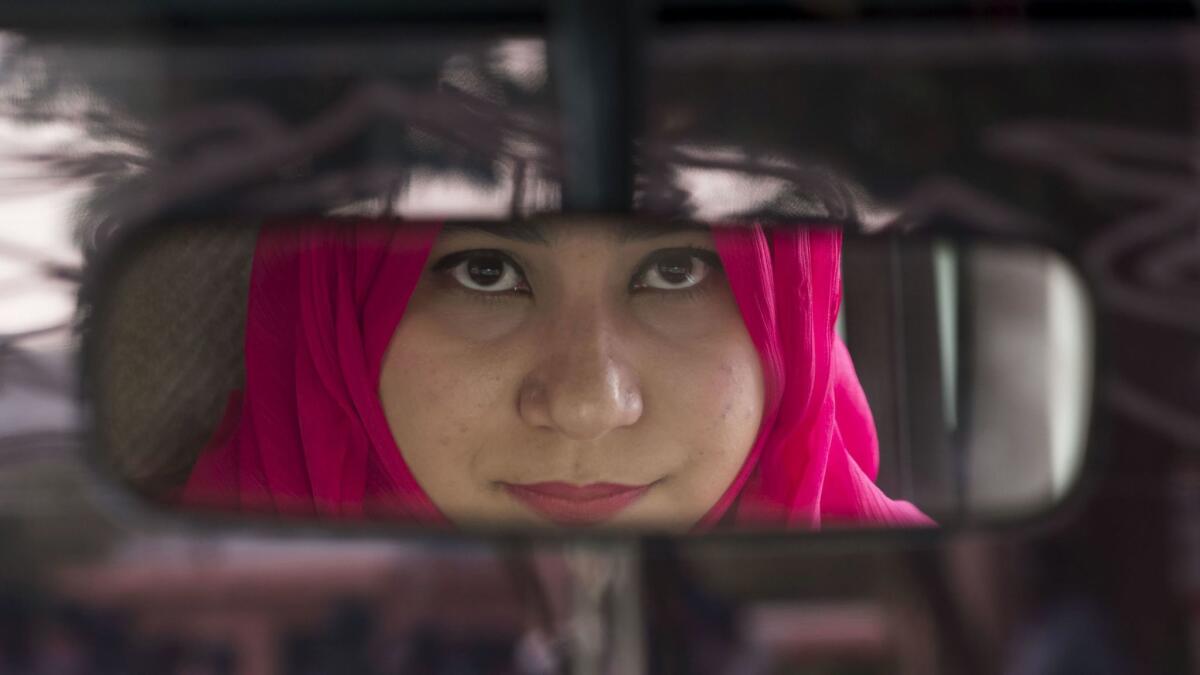
Although International Women’s Day has not attracted the same attention in the U.S. in years past, it is a bigger occasion in other parts of the world.
Across Russia, men bought flowers for their wives, mothers and daughters. Four women were briefly detained after a group of feminist activists unfurled a banner outside the Kremlin reading, “Men have been in power for 200 years! Get out!”
Women in Poland held marches to demand protection from gender-based violence. In Ireland, thousands marched through the capital, Dublin, to protest the country’s restrictive abortion laws, bringing traffic to a standstill. In Spain, women gathered in a Madrid Square to protest a culture of “machismo.”
Many women in France stopped working at 3:40 p.m., the hour from which they claimed they would be working for free, given differences in pay with their male colleagues.
“People talk a lot about human rights and equality in France, but in reality it’s not applied,” said Nathalie Andrieux-Hennequin, a social worker, who joined a demonstration in Paris.
There was some grumbling in the Brazilian city of Sao Paulo, when women’s voices were initially drowned out by male colleagues at a union-backed rally to demand equal rights for all.
“I understand the demands that they’re making, but they shouldn’t be doing this here, and they shouldn’t be doing it today,” said Fernanda Obregon, a cultural researcher. “It shows how much we really need this day. It is so disrespectful to women.”
There were also demonstrations of solidarity from governments and businesses.
The government in Iceland said it would introduce legislation this month requiring employers to prove that they offer equal pay for equal work.
The British government unveiled a new budget that includes an additional $24 million for charities that fight domestic violence.
In Germany, the airline Lufthansa had six all-female crews flying from several cities to the capital, Berlin.
Times staff writers Zavis, King and Demick reported from Los Angeles, Washington and New York, respectively. Special correspondent Jarvie reported from Atlanta. Staff writer Alene Tchekmedyian and special correspondents Christina Boyle, Kim Willsher, Mansur Mirovalev and Jill Langlois contributed from Los Angeles, London, Paris, Moscow and Sao Paulo respectively.
Twitter: @alexzavis
Twitter: @laurakingLAT
Twitter: @BarbaraDemick
ALSO
From social media blackouts to celeb tweets, Hollywood salutes International Women’s Day
At the Made in America Store, it’s a challenge to keep the aisles full
Fearful immigrants in U.S. make perilous winter crossing to seek protection in Canada
UPDATES:
6:35 p.m.: Updated with additional details about the international protests.
4:35 p.m.: Updated with additional details about the U.S. protests.
12:40 p.m.: The article was updated with tweets from President Trump.
This article was originally published at 12 p.m.
More to Read
Sign up for Essential California
The most important California stories and recommendations in your inbox every morning.
You may occasionally receive promotional content from the Los Angeles Times.

